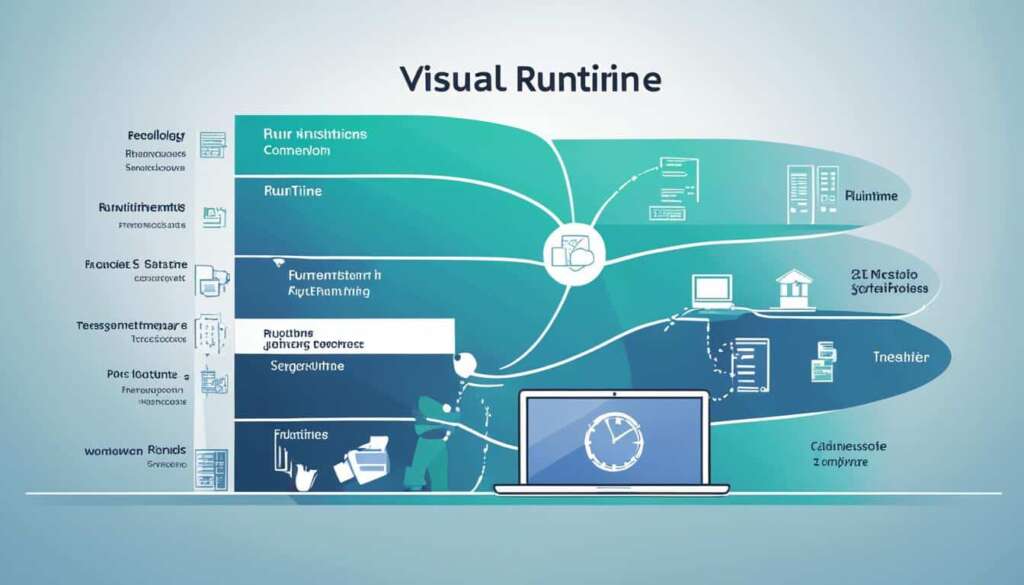Table of Contents
A runtime in computing refers to the software or instructions that are executed while a program is running. It plays a pivotal role in the execution and performance of software. It includes the code that is necessary for the proper execution of a program, especially the instructions that are not explicitly written by the programmer. The runtime interacts with the program code, providing the necessary functions and resources for the program to run. It can be thought of as the layer that sits between the operating system and the program, allowing the program to interact with the computing resources it needs.
What Is a Runtime Made Of
A runtime is composed of various components depending on the programming language and platform. These components work together to enable the execution of software applications. Two essential components of a runtime are the runtime library and the virtual machine.
Runtime Library
The runtime library is a collection of functions that are built into the programming language, providing developers with a set of pre-defined functionalities. It offers a range of tasks such as input and output operations, memory management, and other common operations required for running a program. By using the runtime library, developers can abstract away low-level programming details and focus on higher-level tasks.
Virtual Machine
The virtual machine is another critical component frequently associated with the runtime. One example of a virtual machine is the Java Virtual Machine (JVM). The virtual machine interprets the bytecode generated by the compiler and executes the program accordingly. It provides a platform-independent environment for the application to run, ensuring compatibility across different operating systems and architectures. The virtual machine also handles memory management and garbage collection, optimizing the runtime performance of the program.
| Runtime Components | Description |
|---|---|
| Runtime Library | A collection of pre-built functions for common tasks such as input/output and memory management. |
| Virtual Machine | An execution environment that interprets bytecode and provides platform independence. |
These runtime components work together to ensure that a program runs efficiently and reliably. The runtime library provides the necessary functions for the program’s execution, while the virtual machine offers a platform-independent execution environment. By understanding the composition of a runtime, developers can leverage these components to optimize their software applications.
How Runtime Interacts with Code
The runtime plays a crucial role in the execution of a program, controlling its flow and ensuring smooth operation. It interacts with the code by managing the program’s execution, allocating necessary resources, and providing the environment for the code to run.
One of the key functions of the runtime is to control the execution of the program. It determines the order in which different parts of the code are executed, ensuring that the program follows the desired logic and sequence of operations. This runtime control allows for efficient and organized program execution, leading to optimal performance.
In addition to controlling the program’s flow, the runtime also manages important resources required for its execution. This includes managing memory allocation and deallocation, ensuring that the program has access to sufficient memory to store data and perform operations. By efficiently managing memory usage, the runtime optimizes program performance and prevents issues like memory leaks.
The runtime also handles exceptions that may occur during program execution. It includes mechanisms for catching and handling runtime errors, such as memory access violations or null pointer exceptions. By providing error handling and recovery mechanisms, the runtime ensures that errors do not halt the program execution and allows for graceful handling of unexpected situations.
The runtime acts as a mediator between the program and the underlying hardware. It ensures that the code is executed correctly and efficiently, translating the program’s instructions into low-level machine instructions that the hardware can understand and execute. This abstraction layer provided by the runtime allows programs to be written in high-level languages while still being able to execute on different hardware architectures.
Overall, the runtime is essential for ensuring the proper execution of a program. Through runtime control, resource management, exception handling, and hardware interaction, it provides the necessary environment for the code to run smoothly and optimally.

Runtime vs. Runtime Library
In the realm of computing, the terms “runtime” and “runtime library” are often used interchangeably. However, it’s important to understand the subtle differences between these two concepts.
The runtime encompasses the entire infrastructure required to execute a program. It includes the execution environment, platform-specific code, and other essential components that enable the program to run smoothly. In essence, the runtime serves as the foundation upon which a program operates.
On the other hand, the runtime library is a specific collection of functions or code provided by the runtime. It offers a range of pre-built functions and APIs that programmers can leverage to abstract away low-level details and perform common tasks. This library acts as a toolset, equipping developers with the necessary resources to expedite software development and streamline their coding process.
To put it simply, while the runtime comprises the entire runtime system, including the runtime library, the runtime library itself is just one component within the overall runtime environment.
Examples of Runtimes
When it comes to programming, there are several examples of runtimes that play a crucial role in software development. One such example is the Java Runtime Environment (JRE). The JRE provides the necessary runtime environment for running Java programs. It includes the Java Virtual Machine (JVM) and the standard library, which are essential for executing Java code. The JRE ensures that Java programs can run smoothly on different operating systems and devices, making it a popular choice for developers.
Another widely used runtime is the Common Language Runtime (CLR) in Microsoft’s .NET Framework. The CLR provides a runtime environment for running programs written in various languages that target the .NET platform. It offers features such as memory management, garbage collection, and execution engine, making it easier for developers to create efficient and scalable applications.
Additionally, the Adobe Flash Player is also considered a runtime environment. It provides the necessary environment for running Flash programs on different operating systems and devices. The Flash Player enables the execution of rich media content, interactive animations, and multimedia applications, making it a prominent runtime in the web development sphere.
These examples demonstrate the diversity and importance of runtimes in modern software development. Whether it’s the Java Runtime Environment, the Common Language Runtime, or the Adobe Flash Player, these runtimes play a crucial role in providing the necessary environment for running programs and ensuring the seamless execution of software.
FAQ
What is a runtime in computing?
A runtime in computing refers to the software or instructions that are executed while a program is running. It plays a pivotal role in the execution and performance of software.
What is a runtime made of?
A runtime is made up of various components depending on the programming language and platform. One important component is the runtime library, which is a collection of functions that are built into the programming language. Another component is the virtual machine, such as the Java Virtual Machine (JVM), which provides a platform-independent execution environment.
How does runtime interact with code?
The runtime interacts with the code by controlling the execution of the program. It manages the flow of the program, allocating resources, and ensuring smooth code execution. It provides the necessary environment for the code to execute, including managing memory, handling exceptions, and coordinating with the operating system.
What is the difference between runtime and runtime library?
The runtime refers to the entire infrastructure required to run a program, including the runtime library. On the other hand, the runtime library is a specific set of functions or code that is provided by the runtime. The runtime library provides pre-built functions and APIs that abstract away low-level details and perform common tasks.
What are some examples of runtimes?
Some examples of runtimes in programming include the Java Runtime Environment (JRE) which provides the necessary environment for running Java programs, the Common Language Runtime (CLR) in Microsoft’s .NET Framework which provides a runtime environment for programs written in various languages, and the Adobe Flash Player which provides the necessary environment for running Flash programs on different operating systems and devices.


